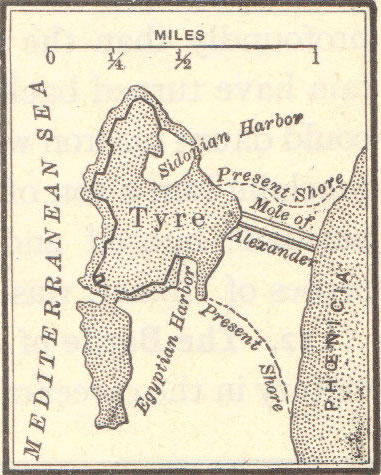 The Siege of Tyre, conducted by Alexander the Great in 332 B.C., is one of the most famous military operations of his career and a pivotal event in his campaign against the Persian Empire. Tyre, a heavily fortified island city located off the coast of modern-day Lebanon, was a major strategic and economic hub due to its strong maritime presence and formidable defenses.
The Siege of Tyre, conducted by Alexander the Great in 332 B.C., is one of the most famous military operations of his career and a pivotal event in his campaign against the Persian Empire. Tyre, a heavily fortified island city located off the coast of modern-day Lebanon, was a major strategic and economic hub due to its strong maritime presence and formidable defenses.
The siege began after the Tyrians refused Alexander's demand to allow him to offer a sacrifice to Heracles in their city. Recognizing the necessity of capturing Tyre to secure his supply lines and prevent Persian naval counterattacks, Alexander initiated a complex and challenging operation. The primary obstacle was the city's insular location, requiring Alexander to construct a massive causeway, or mole, from the mainland to the island, allowing his siege engines to approach the walls.
The construction of the causeway faced numerous difficulties, including Tyrian naval assaults and strong defenses. Despite these challenges, Alexander's engineers and soldiers persisted, using a combination of land-based siege engines and naval support to push forward. The Tyrians fought fiercely, employing fire ships and counterattacks to delay the Macedonian advance.
After seven months of intense effort, Alexander's forces finally breached Tyre's walls. The Macedonians stormed the city, leading to fierce street fighting. The eventual capture of Tyre resulted in significant casualties and the enslavement of many Tyrian inhabitants. The fall of Tyre demonstrated Alexander's relentless determination and strategic ingenuity, securing his control over the Eastern Mediterranean and marking a crucial step in his conquest of the Persian Empire.
|
 The Siege of Tyre, conducted by Alexander the Great in 332 B.C., is one of the most famous military operations of his career and a pivotal event in his campaign against the Persian Empire. Tyre, a heavily fortified island city located off the coast of modern-day Lebanon, was a major strategic and economic hub due to its strong maritime presence and formidable defenses.
The Siege of Tyre, conducted by Alexander the Great in 332 B.C., is one of the most famous military operations of his career and a pivotal event in his campaign against the Persian Empire. Tyre, a heavily fortified island city located off the coast of modern-day Lebanon, was a major strategic and economic hub due to its strong maritime presence and formidable defenses.















